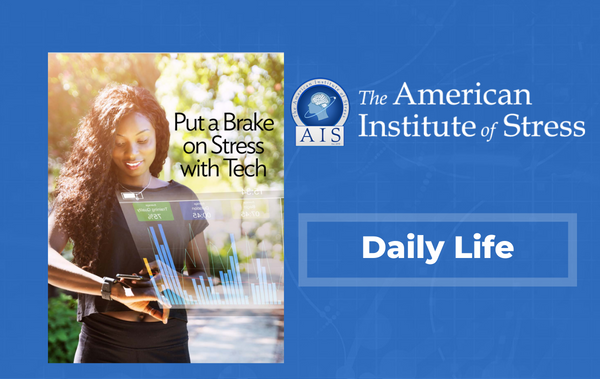*This is an article from the Fall 2022 issue of Contentment Magazine.
Evian Gordon, MD, PhD, FAIS
Founder and Chief Medical Officer Total Brain
Donna Palmer, PhD
Chief Science Officer, Total Brain.com
Jennifer Franklin
Founder of Totally Immune.com
Technology is often criticized as a source of stress. Most people would agree that hours of scrolling social media is not beneficial to our mental health and having work email literally at-hand 24/7 can make it hard to ever switch off. But while tech can be a curse, it is also a blessing when used as an instrument to reduce stress and boost positivity.
Having control over stress in any situation means knowing your stress triggers and finding the specific training techniques that best induce a relaxation response. There are also specific situations where inducing calm in-the- moment is particularly critical to your wellbeing and effectiveness. Technologies allow assessment, training and tracking of the solutions and benefits in these situations, daily for engagement and even in real-time to boost the immersive nature of self-care.
There is an abundance of apps for mindfulness meditation, brain training, neurostimulation, tracking stress, health measures and wellness. It can seem overwhelming, but with an awareness of these technologies, you can empower yourself to reduce stress and objectively track your results with quantifiable measures. With cutting-edge biometrics such as Heart Rate Variability (HRV) technology now available on fitness bands, you can see in real-time what works best to engage your relaxation response and decrease your stress level.
The Dynamics of Stress
Emotions give you a short cut to rapidly evaluate every interaction and situation in your life and determine if they are threatening or rewarding. Your brain’s emotion networks continually and rapidly scan for cues from your environment or people’s body language, that then quickly informs you of an impending threat or reward.1
Emotions also drive your Stress Feelings. Emotions and feelings are different but directly complementary. Feelings are physical responses to emotions. Emotions are the cause. Feelings are the effect.
Emotions trigger feelings and create a conscious awareness in your body, in the form of changes in heart rate, sweating, breathing and ‘gut’ activation. Stress is generated when ‘emotion cue triggers’ constantly pick up threat-cues in the environment and hijack the brain into a stress response. This detection of threat could be a realistic evaluation of the surrounding environment, or it could also be that you are overly ‘tuned-in’ to detecting potential threat, and not paying attention to all the reward cues that are also around you. Stress is also generated when life’s demands exceed our capacity to cope.
The stress response is a general alarm to deal with any perceived threat. It is helpful when in physical danger and to provide energy to enhance performance. But when stress is continually triggered, it becomes chronic and toxic to wellbeing, chronic illnesses, mental illness, and all performance.
On the opposite end of the spectrum to the stress response, is the Relaxation Response, which induces a calm and flexible brain and body state. Life is an ongoing fluctuation of Stress-Distress (Amygdala Fight-Flight reflex) and Calm-Flexible (Vagus nerve activated) states.
The good news is that technology has increased the options of solutions that help us feel confident that there is a lot we can do to trigger the Relaxation Response ourselves, to shift into a state that is calmer, healthier, and more cognitively flexible and productive.
How to use tech to decrease Stress and enhance Relaxation.

Figure 1. A selected spectrum of online and biometric assessment, stress reduction and success tracking solutions.
Planning is essential to generating any new habit and this is where tech is brilliant. There are many apps to assess, train and track goals and habits (as indicated in figure 1), so it is only a matter of discovering in a step-by-step manner, which ones work best for you. The plan for generating a sustainable new habit, in this case reducing stress, is to personalize what you ‘will do’ and not ‘should do’ to systematically Assess, Train and Track.
Assess
Step 1 is to measure your baseline. Where you are right now. The key to changing anything is to first measure it and know exactly where you are starting. Multiple online assessments to assess stress, such as the Stress Mastery Questionnaire (AIS),2 the Stress 360 (Dr Heidi Hanna),3 and the relationship between stress and key brain capacities (Total Brain.com)4 are available.
Assessment also includes continuous and mobile phone camera measures of Heart Rate Variability (HRV). HRV is the measure of time between your heart beats. Having a more variable heart rate is optimal and reflects a calmer and more flexible state. It is a measure of how effectively you activate your relaxation response and de-activate your stress response. HRV measures our stress levels to predict wellbeing, physical and mental health. It provides personalized insights about your in-the-moment stress, and what increases and decreases that stress.
Continuous biometric (body and brain measures) monitoring will help assess and track the best timing to provide the most impactful personalized interventions.
Behavior Change is an ‘Inside Job.’ Technology empowers you to be at the center of your own solution, so that you are more likely to become an ongoing active driver of your own health solutions.
Train
A spectrum of technology solutions is available to reduce stress (see figure 1).
For example: it is well-established that breathing at 6 breaths per minute (Resonant Breathing)5 and resonant breathing biofeedback is a fast and effective way to activate your relaxation response. In as little as 2-3 minutes of deep resonant breathing your stress response will notably decrease and can put you in a calm and positive brain state after training. There are many breathing apps to enhance the experience with beautiful nature scenes and music. Apps also have the added benefit giving you visual guide to breathe at the right pace, and a timer to set the exercise length and be told when it’s finished. This is not only immersive and personalized, but the moving bar distracts from and can break the track of negative thoughts. (Try it… it’s hard to watch a moving bar and think of a negative thought at the same time.)
In addition to feeling less stressed with breathing exercises, you can also see your stress response decrease with the HRV technology in many fitness bands, giving you an objective measure of stress decrease in real time. You can also use HRV technology as an objective measure to track when your stress is starting to rise again and use this as a signal to reduce it with a quick breathing exercise.
Other calm training tools include online meditation, brain training of calm, training emotion awareness and positivity, entrainment music, HRV biofeedback, EEG Neurofeedback and Neurostimulation (see figure 1).
It requires systematic repetition but not a huge time commitment to see and feel results.

Figure 2: Significant stress reduction with brain training of a total of 2 hours.
The Total Brain team has shown that training for about 2 hours in total (for example 10 minutes a day, 3 times a week for 4 weeks) will objectively show a statistically significant effect. This was an analysis from 90,000 people training with TotalBrain.com stress reduction tools such as Resonant Breathing, Neurotunes and guided Mindfulness Meditation.6
To re-iterate the obvious that in all technology training there is a dose-effect: the more you train the bigger the benefit. The KEY to any training is to find what you will do, create small steps to maximize success, and track your progress. Feeling better is just one benefit of training. Seeing measurable improvements increases your likelihood to keep at it. Winning activates dopamine, your feel good and motivation brain reward.
Track
“If you don’t measure it, you can’t manage it.” With technology it is super easy to track your training and progress. Technology platforms increasingly provide a one- stop shop for Assessing, Training and Tracking, and there are a variety of choices to suit your style and needs.
Having control over stress in any situation comes from knowing your stress triggers and finding the specific training techniques that best induce a relaxation response. There are also specific situations where inducing calm in-the-moment is critical to your wellbeing and effectiveness. HRV monitoring can help you achieve this.
Technology empowers you to be at the center of your own solution, so that you become an active participant in your own health solutions. Feeling better is just one benefit of training. Seeing measurable improvements increases your likelihood to keep at it. Winning activates dopamine, your feel good and motivation brain reward. Practicing Assess, Track and Train for as little as 10 minutes a day will create an environment of victory. Tech empowers you to not only put a brake on stress, but to also unleash a self-guided evidence-based plan to choose yourself.
Take Aways
- Online and biometric technology empowers you to assess-train-track how to switch stress into calm.
- Embrace the judicious use of technology to discover what objectively works best for you to master stress, in the moment and in the long run.
References
- Dr Evian Gordon (2022). THE BRAIN: From Knwoing to Doing! Franklin Publishers.
- https://www.stress.org/self-assessment
- Stress 360 Assessment: heidihanna.com/free-stress-survey
- Stress and Cognition Assessment: totalbrain.com/KnowingToDoing
- Resonant Breathing and HRV: https://thequantifiedbody.net/heart-rate-variability-biofeedback-richard-gevirtz/
- Gordon E., Palmer D et al. (2013). Online Cognitive Brain Training Associated with Measurable Improvements in Cognition and Emotional Well- being. Technology and Innovation. 15 (1): 53-62.
ABOUT THE AUTHOR

Dr. Evian Gordon is the Founder, Chairman and Chief Medical Officer (CMO) of Total Brain. He founded the largest standardized International Brain Database (over 1 million datasets) to discover what insights and behavioral habits are most effective in stress, mental health, wellness and peak performance. He also founded https://www.totalbrain.com, an online mental health and performance platform to empower users to self-monitor and support self-care of their mental health, wellness and peak performance. Having published over 250 peer-reviewed scientific publications, Dr. Gordon is a Fellow of The American Institute of Stress (AIS) and featured in the Institute’s 2021 documentary, Mismatched: Your Brain Under Stress. Dr. Gordon is a recipient of the inaugural Royal Societies Eureka Prize for Interdisciplinary Scientific Research. He hosts the Total Brain Podcast with key opinion leaders around the world on Behavior Change. Publication details at: https://www.dreviangordon.com/
 Dr. Donna Palmer is a cognitive neuroscientist specializing in emotional brain functioning and integrative neuroscience. Dr. Palmer is the Chief Scientific Officer at Total Brain and a Research Affiliate of the Brain Dynamics Center, Westmead Millennium Institute and Sydney Medical School, The University of Sydney.
Dr. Donna Palmer is a cognitive neuroscientist specializing in emotional brain functioning and integrative neuroscience. Dr. Palmer is the Chief Scientific Officer at Total Brain and a Research Affiliate of the Brain Dynamics Center, Westmead Millennium Institute and Sydney Medical School, The University of Sydney.
Jennifer Franklin is a fitness and wellness coach for national gym chains. Founder of totallyimmune.com, a website to train people through psychoneuroimmunology to boost their immune system. https://www.totallyimmune.com/ She has a background in communications, multi-media and wellness education. Presented and produced major league sport content for Univision Communications.
through psychoneuroimmunology to boost their immune system. https://www.totallyimmune.com/ She has a background in communications, multi-media and wellness education. Presented and produced major league sport content for Univision Communications.
*All 3 authors contributed to the development of the ThinkHeart online “Lifestyle Medicine” course with The American Heart Association (AHA) to enhance Calm, Move, Eat and Connect. https://thinkheart.totalbrain.com/


